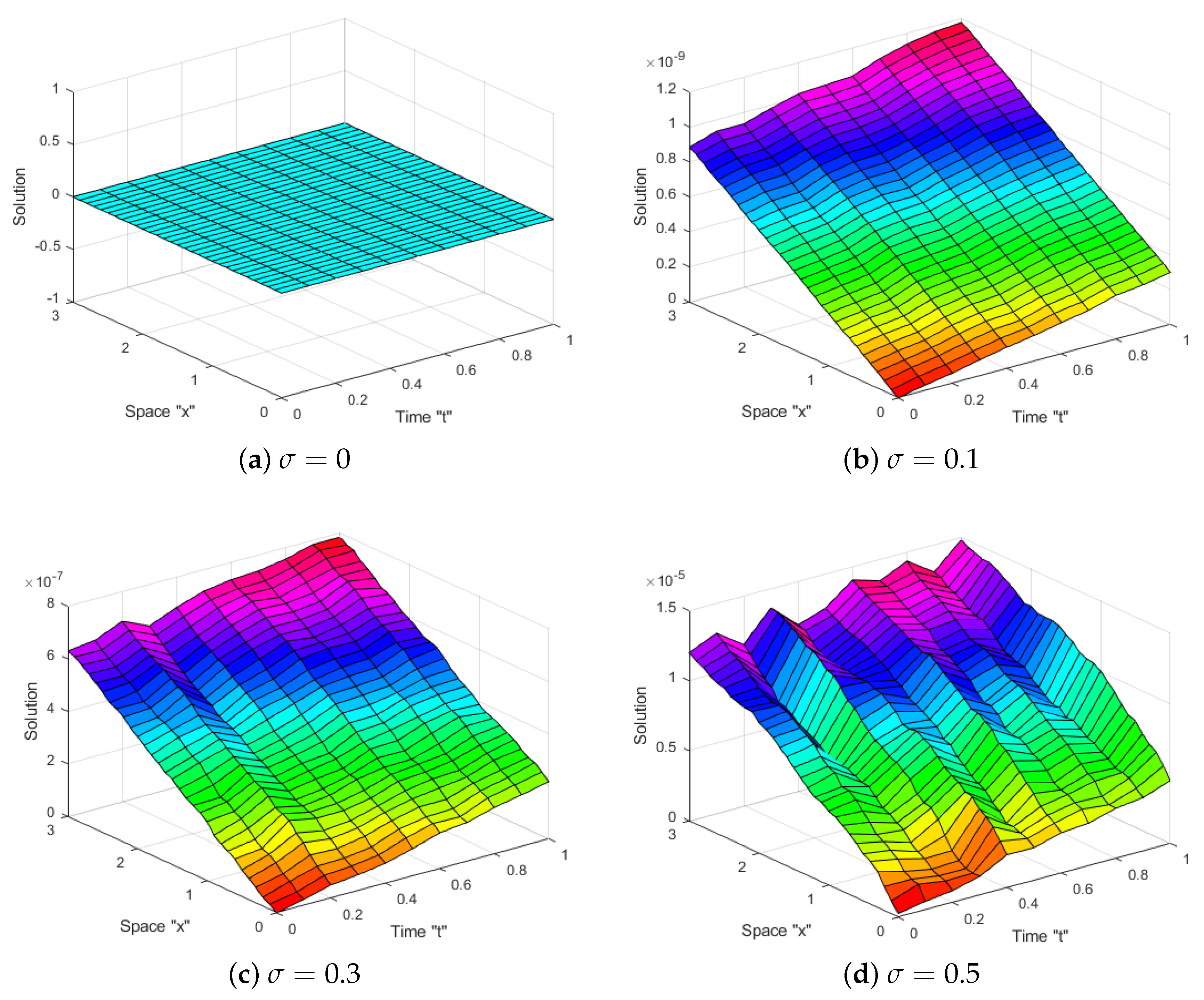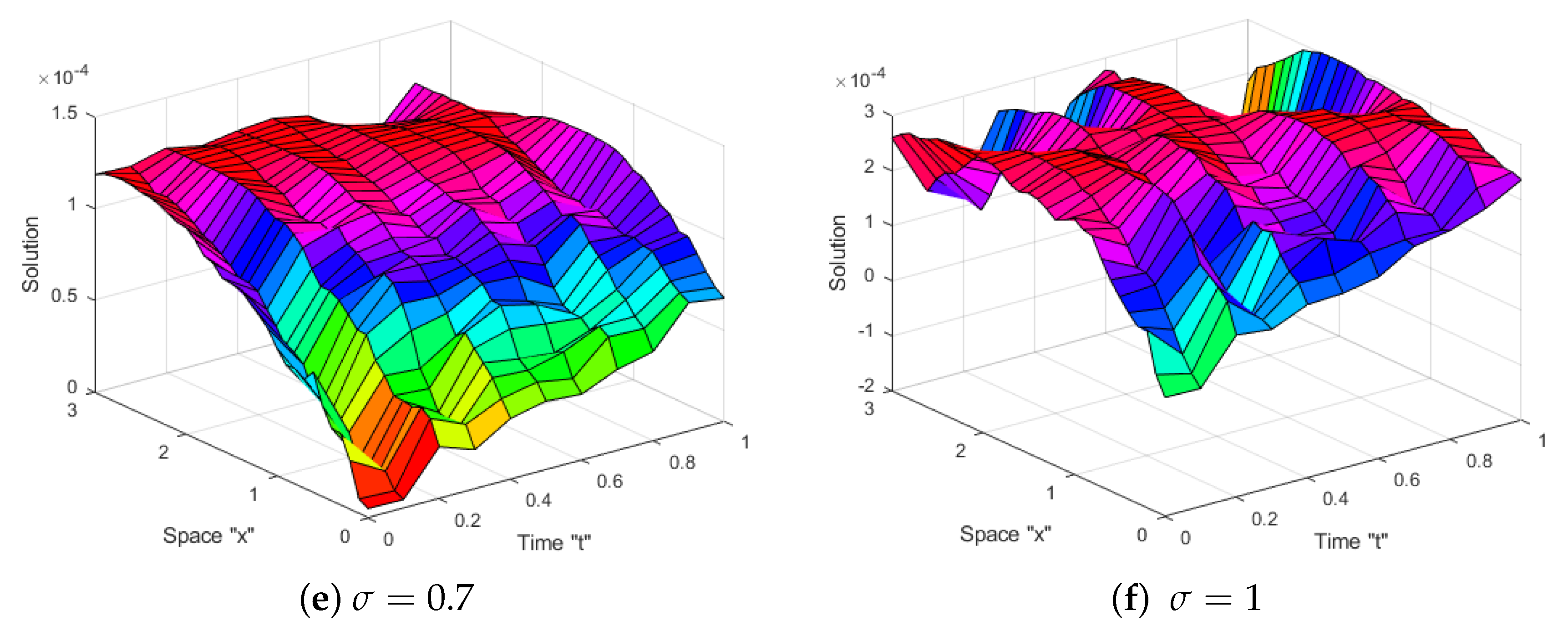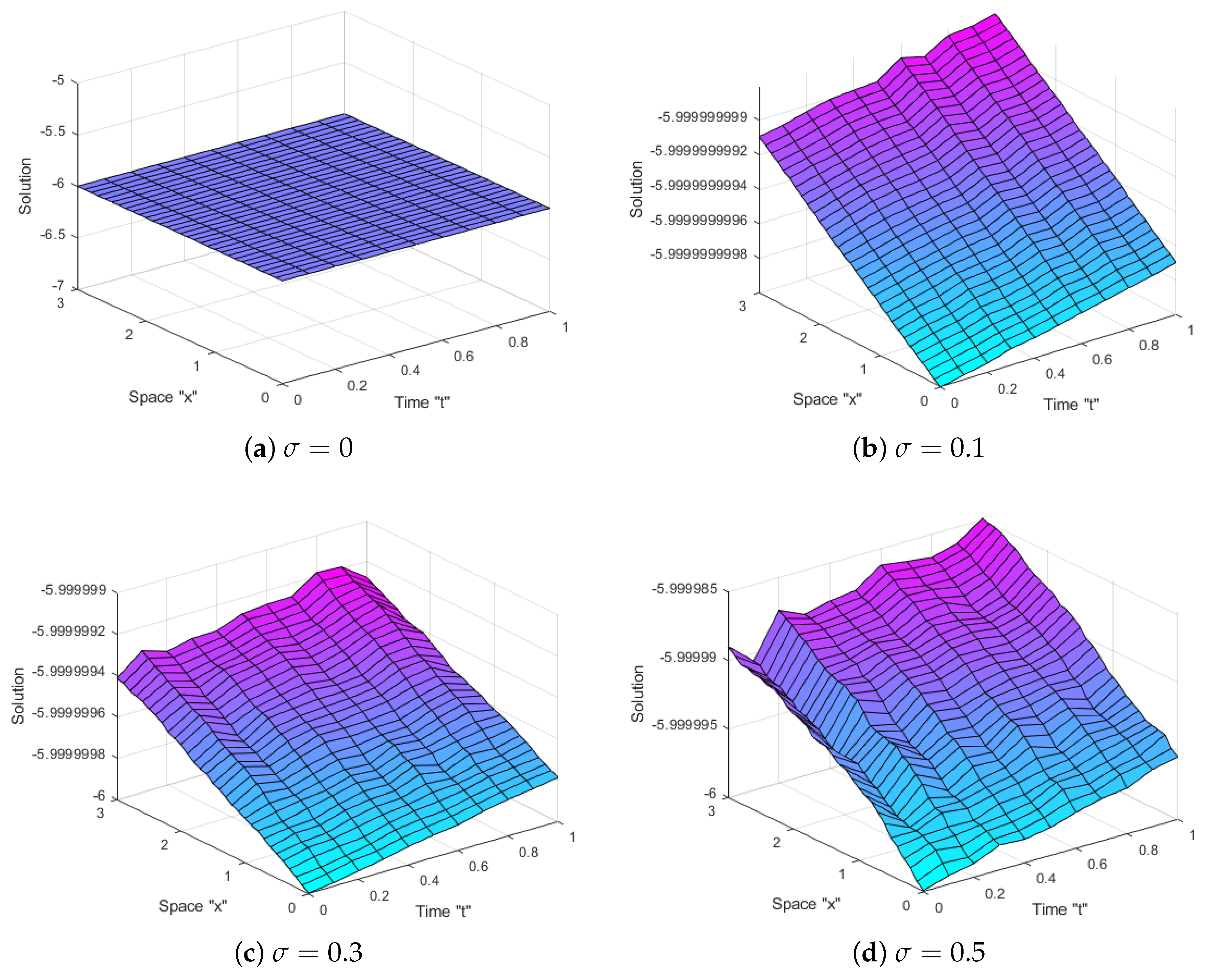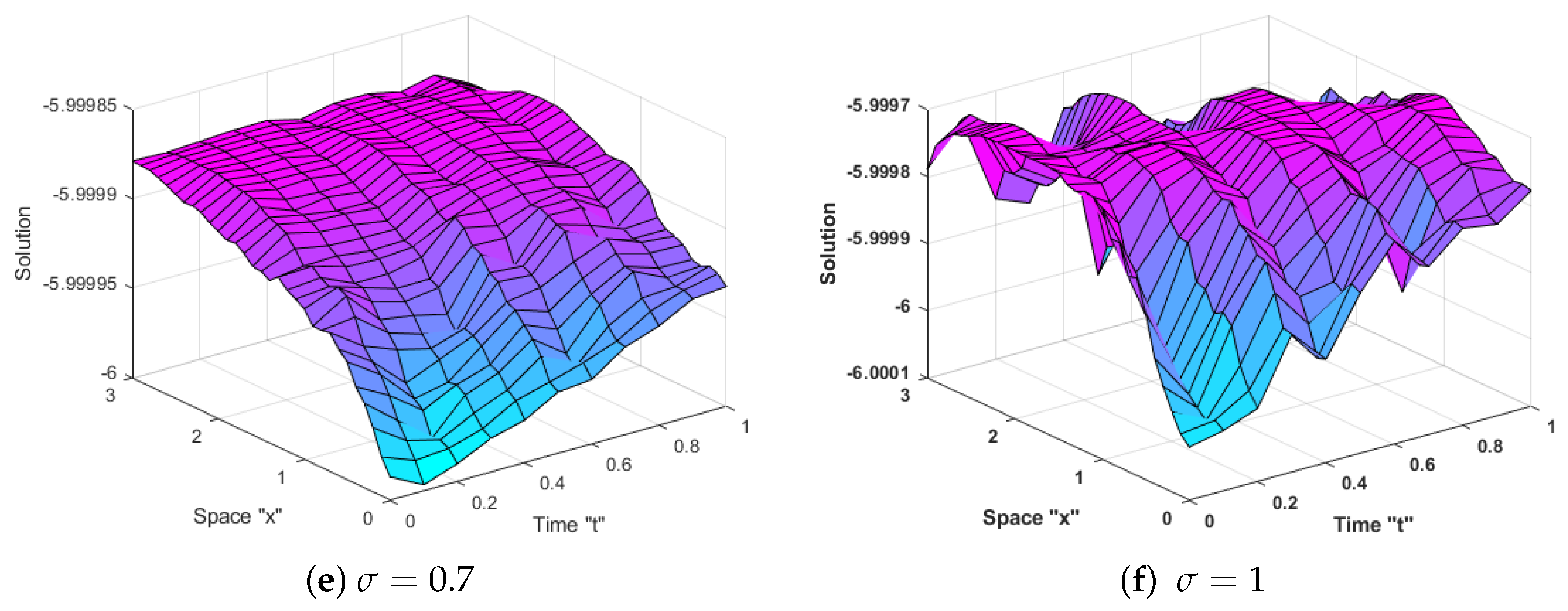Abundant Exact Traveling-Wave Solutions for Stochastic Graphene Sheets Model
Abstract
1. Introduction
2. Preliminaries
3. Solutions of DGSM
4. Exact Solutions of SGSM
5. Conclusions
Author Contributions
Funding
Informed Consent Statement
Data Availability Statement
Conflicts of Interest
References
- Baskonus, H.M.; Bulut, H.; Sulaiman, T.A. New complex hyperbolic structures to the lonngren-wave equation by using sine-gordon expansion method. Appl. Math. Nonlinear Sci. 2019, 4, 129–138. [Google Scholar] [CrossRef]
- Lu, B. The first integral method for some time fractional differential equations. J. Math. Anal. Appl. 2012, 395, 684–693. [Google Scholar] [CrossRef]
- Jiong, S. Auxiliary equation method for solving nonlinear partial differential equations. Phys. Lett. A 2003, 309, 387–396. [Google Scholar]
- Yan, Z.L. Abunbant families of Jacobi elliptic function solutions of the dimensional integrable Davey-Stewartson-type equation via a new method. Chaos Solitons Fractals 2003, 18, 299–309. [Google Scholar] [CrossRef]
- Mohammed, W.W.; Cesarano, C.; Al-Askar, F.M. Solutions to the (4+1)-Dimensional Time-Fractional Fokas Equation with M-Truncated Derivative. Mathematics 2023, 11, 194. [Google Scholar] [CrossRef]
- Wang, M.L.; Li, X.Z.; Zhang, J.L. The (G′/G)-expansion method and travelling wave solutions of nonlinear evolution equations in mathematical physics. Phys. Lett. A 2008, 372, 417–423. [Google Scholar] [CrossRef]
- Zhang, H. New application of the (G′/G)-expansion method. Commun. Nonlinear Sci. Numer. Simul. 2009, 14, 3220–3225. [Google Scholar] [CrossRef]
- Wazwaz, A.M. The sine-cosine method for obtaining solutions with compact and noncompact structures. Appl. Math. Comput. 2004, 159, 559–576. [Google Scholar] [CrossRef]
- He, J.H.; Wu, X.H. Exp-function method for nonlinear wave equations. Chaos Solitons Fractals 2006, 30, 700–708. [Google Scholar] [CrossRef]
- Khan, K.; Akbar, M.A. The exp(−ϕ(ς))-expansion method for finding travelling wave solutions of Vakhnenko-Parkes equation. Int. J. Dyn. Syst. Differ. Equ. 2014, 5, 72–83. [Google Scholar]
- Mohammed, W.W. Approximate solution of the Kuramoto-Shivashinsky equation on an unbounded domain. Chin. Ann. Math. Ser. B 2018, 39, 145–162. [Google Scholar] [CrossRef]
- Mohammed, W.W.; Iqbal, N.; Botmart, T. Additive Noise Effects on the Stabilization of Fractional-Space Diffusion Equation Solutions. Mathematics 2022, 10, 130. [Google Scholar] [CrossRef]
- Taya, S.A.; Daher, M.G.; Almawgani, A.H.M.; Hindi, A.T.; Colak, I.; Patel, S.K.; Pal, A. Absorption Properties of a One-Dimensional Photonic Crystal with a Defect Layer Composed of a Left-Handed Metamaterial and Two Monolayer Graphene. Phys. Status Solidi Appl. Res. 2023, 220, 2300164. [Google Scholar] [CrossRef]
- Bradley, A.N.; Thorp, S.G.; Mayonado, G.; Coporan, S.A.; Elliott, E.; Graham, M.W. Photoreduced graphene oxide recovers graphene hot electron cooling dynamics. Phys. Rev. B 2023, 107, 224309. [Google Scholar] [CrossRef]
- Model, J.C.M.; Veit, H.M. Development of a More Sustainable Hybrid Process for Lithium and Cobalt Recovery from Lithium Ion Batteries. Minerals 2023, 13, 798. [Google Scholar] [CrossRef]
- Khater, M.M.A.; Alfalqi, S.H.; Vokhmintsev, A. High-Precision computational solutions for nonlinear evolution models in graphene sheets. Sci. Rep. 2025, 15, 4013. [Google Scholar] [CrossRef] [PubMed]
- Exact solutions of stochastic Burgers–Korteweg de Vries type equation with variable coefficients. Partial Differ. Equ. Appl. Math. 2024, 11, 100753. [CrossRef]
- Calin, O. An Informal Introduction to Stochastic Calculus with Applications; World Scientific: Singapore, 2015. [Google Scholar]
- Kloeden, P.E.; Platen, E. Numerical Solution of Stochastic Differential Equations; Springer: Berlin/Heidelberg, Germany, 1992. [Google Scholar]
- Fan, E. Extended tanh-function method and its applications to nonlinear equations. Phys. Lett. A 2000, 277, 212–218. [Google Scholar] [CrossRef]
- Higham, D.J. An algorithmic introduction to numerical simulation of stochastic differential equations. SIAM Rev. 2001, 43, 525–546. [Google Scholar] [CrossRef]




Disclaimer/Publisher’s Note: The statements, opinions and data contained in all publications are solely those of the individual author(s) and contributor(s) and not of MDPI and/or the editor(s). MDPI and/or the editor(s) disclaim responsibility for any injury to people or property resulting from any ideas, methods, instructions or products referred to in the content. |
© 2025 by the authors. Licensee MDPI, Basel, Switzerland. This article is an open access article distributed under the terms and conditions of the Creative Commons Attribution (CC BY) license (https://creativecommons.org/licenses/by/4.0/).
Share and Cite
Mohammed, W.W.; Hassan, T.S.; Sidaoui, R.; Alshammary, H.; Algolam, M.S. Abundant Exact Traveling-Wave Solutions for Stochastic Graphene Sheets Model. Axioms 2025, 14, 477. https://doi.org/10.3390/axioms14060477
Mohammed WW, Hassan TS, Sidaoui R, Alshammary H, Algolam MS. Abundant Exact Traveling-Wave Solutions for Stochastic Graphene Sheets Model. Axioms. 2025; 14(6):477. https://doi.org/10.3390/axioms14060477
Chicago/Turabian StyleMohammed, Wael W., Taher S. Hassan, Rabeb Sidaoui, Hijyah Alshammary, and Mohamed S. Algolam. 2025. "Abundant Exact Traveling-Wave Solutions for Stochastic Graphene Sheets Model" Axioms 14, no. 6: 477. https://doi.org/10.3390/axioms14060477
APA StyleMohammed, W. W., Hassan, T. S., Sidaoui, R., Alshammary, H., & Algolam, M. S. (2025). Abundant Exact Traveling-Wave Solutions for Stochastic Graphene Sheets Model. Axioms, 14(6), 477. https://doi.org/10.3390/axioms14060477






